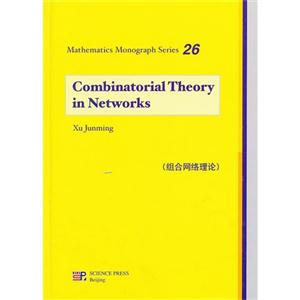组合网络理论-26
本书特色
[
this book provides the most basic combinatorial problems and well-established theory in design and analysis of the topological structure of interconnection networks in the graph-theoretic language.it covers the basic methods of network design,several well-known networks such as hypercubes,de bruijn digraphs,kautz digraphs,double loop,and the newest parameters to measure performance of networks such as forwarding indices of a routing,menger number,rabin number,fault-tolerant diameter,wide-diameter,generalized dominating number,and restricted connectivity.it will be of significant interest to researchers and practitioners working in design and analysis of networks,particularly to undergraduates and postgraduates specializing in computer science and applied mathematics.
xu junming is a professor at school of mathematical sciences,the university of science and technology of china(ustc),a fellow of operations research society of china,and commission on combinatorics and graph theory in china.his research interest is combinatorics and graph theory,in particular,combinatorial problems of interconnection networks,has published more than 200 research papers.
]
目录
prefacepart ⅰ networks and graphschapter 1 fundamentals of networks and graphs1.1 graphs and networks1.2 basic concepts and notations1.3 trees and planar graphs1.4 transmission delay and diameter1.5 fault tolerance and connectivity1.6 embedding and routings1.7 basic principles of network designexerciseschapter 2 symmetry of graphs or networks2.1 fundamentals on groups2.2 vertex-transitive graphs2.3 edge-transitive graphs2.4 atoms of graphs2.5 connectivity of transitive graphsexercisespart ⅱ basic methods of network designschapter 3 line graphical methods3.1 line graphs and basic properties3.2 basic properties of line digraphs3.3 iterated line graphs3.4 connectivity of line graphsexerciseschapter 4 cayley methods4.1 cayley graphs4.2 transitivity of cayley graphs4.3 atoms and connectivity of cayley graphs4.4 vertex-transitive graphs with prime orderexerciseschapter 5 cartesian product methods5.1 cartesian product of graphs5.2 diameter and connectivity5.3 other properties of cartesian products5.4 generalized cartesian productsexerciseschapter 6 basic problems in optimal designs6.1 undirected(d,k)-graph problems6.2 directed(d,k)-graph problems6.3 relations between diameter and connectivityexercisespart ⅲ well-known topologies of networkschapter 7 hypercube networks7.1 definitions and basic properties7.2 gray codes and cycles7.3 lengths of paths7.4 embedding problems7.5 generalized hypercubes7.6 some variations of hypercubesexerciseschapter 8 de bruijn networks8.1 definitions and basic properties8.2 uniqueness of shortest paths8.3 generalized de bruijn digraphs8.4 comparison with hypercubesexerciseschapter 9 kautz networks9.1 definitions and basic properties9.2 generalized kautz digraphs9.3 connectivity of generalized kautz digraphsexerciseschapter 10 double loop networks10.1 double loop networks10.2 l-tiles in the plane10.3 l-tiles and double loop networks10.4 design of optimal double loop networks10.5 basic properties of circulant networksexerciseschapter 11 topologies of other networks11.1 mesh networks and grid networks11.2 pyramid networks11.3 cube-connected cycles11.4 butterfly networks11.5 bene* networks11.6 ω networks11.7 shuffle-exchange networksexercisespart ⅳ fault-tolerant analysis of networkschapter 12 routings in networks12.1 forwarding index of routing12.2 edge-forwarding index of routing12.3 forwarding indices of some graphs12.4 delay of fault-tolerant routingexerciseschapter 13 fault-tolerant diameters in networks13.1 diameters of altered graphs13.2 edge fault-tolerant diameters13.3 relations between two diameters13.4 vertex fault-tolerant diameters13.5 fault-tolerant diameter of product graphs13.6 fault-tolerant diameters of some networksexerciseschapter 14 menger-type problems in parallel systems14.1 menger-type problems14.2 bounded menger number and connectivity14.3 bounded edge-connectivity14.4 rabin numbers of networksexerciseschapter 15 wide-diameters of networks15.1 wide-diameter and basic results15.2 wide-diameter of regular graphs15.3 wide-diameter of cartesian products15.4 wide-diameter and independence number15.5 wide-diameter and fault-tolerant diameter15.6 wide-diameters of some networksexerciseschapter 16 generalized independence and domination numbers16.1 generalized independence numbers16.2 generalized domination numbers16.3 distance independence and dominationexerciseschapter 17 restricted fault-tolerance of networks17.1 restricted connectivity and diameter17.2 restricted edge-connectivity17.3 restricted edge-atoms17.4 results on transitive graphs17.5 super connectivity of networks17.6 super edge-connectivity of networks17.7 super connectivity of line graphs17.8 connectivity restricted by degree-conditions17.9 connectivity restricted by order-conditions17.10 restricted connectivity of some networksexercisesbibliographya list of notationsindex
封面

书名:组合网络理论-26
作者:徐俊明
页数:409
定价:¥128.0
出版社:科学出版社
出版日期:2013-03-01
ISBN:9787030364784
PDF电子书大小:114MB 高清扫描完整版
